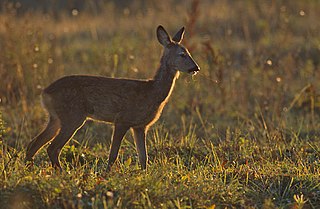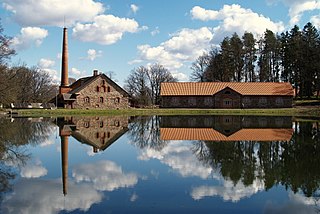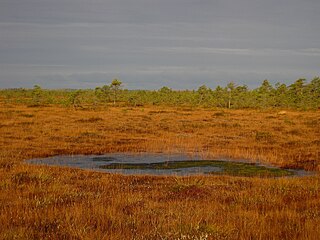
Kuresoo Bog is a bog in Viljandi County, Estonia. [1] The bog is located in Soomaa National Park. [1] This bog is one of the largest in Estonia.
The area of the bog is 10,843 ha. [1]

Kuresoo Bog is a bog in Viljandi County, Estonia. [1] The bog is located in Soomaa National Park. [1] This bog is one of the largest in Estonia.
The area of the bog is 10,843 ha. [1]
The restoration of Kuresoo Bog has been an ongoing effort in Estonia, the main goal of the restoration is to use different damming technologies, such that Sphagnum growth is at a good level. [2]

Pärnu County is one of 15 counties of Estonia. It is situated in the south-western part of the country, on the coast of Gulf of Riga, and borders Lääne and Rapla counties to the north, Järva and Viljandi counties to the east, and Latvia to the south. In January 2013 Pärnu County had a population of 81,428 – constituting 6.3% of the total population of Estonia.
Estonian Fund for Nature or ELF is an Estonian environmental non-profit organisation.

Soomaa National Park is a national park in south-western Estonia. Soomaa protects 390 km², the park was created in 1993. Soomaa is Important Bird Area since 1989 and a Ramsar site of protected wetlands since 1997 and a Natura 2000 area since 2004.

Nigula Nature Reserve is a nature reserve situated in South-West of Estonia, in Häädemeeste and Saarde parishes of Pärnu County. It has an area of 63.98 km². Nigula nature reserve is one of the oldest bog reserves in Estonia. It is established to protect the Nigula Bog and its surrounding forests in their natural state.
Jürgen Kuresoo is an Estonian professional footballer, playing for FC Elva in Estonian III Liiga Lõuna. He plays the position of Midfielder and is 1.76 m tall.
Andrei Borissov is an Estonian football coach and former professional footballer. He played the position of midfielder and is 1.77 m tall and weighs 76 kg. Borissov is the former member of the Estonia national football team, with 14 caps to his name.
Protected areas of Estonia are regulated by the Nature Conservation Act, which was passed by the Estonian parliament on April 21, 2004 and entered into force May 10, 2004. Overall Estonia has 15403 Protected Areas covering 21.21% of the country land and 18.78% of it marine and coastal territory.

Estonia is a small, heavily forested country situated on the Baltic Sea. It is a part of the Euro-Siberian region of terrestrial Palearctic realm, and the Temperate Northern Atlantic marine ecoregion.

Põhja-Kõrvemaa Nature Reserve is a protected area in Harju County, Northern Estonia, some 50 km east of Tallinn. With an area of 130.9 km2, it is the third largest nature reserve in Estonia. Dominated by forests and bogs, it aims to protect rare and endangered species, their habitats, and valuable natural landscapes.

Estonia and the United Kingdom are full members of the Council of Europe and NATO.

Suure-Jaani Parish was a rural municipality of Estonia, in Viljandi County. It had a population of 6,178 and an area of 742.83 km².
2010–11 Estonian Cup is the twenty-first season of the Estonian football knockout tournament organized by the Estonian Football Association. On 10 May 2011, FC Flora Tallinn defeated JK Narva Trans in the final to win the cup and qualify for the second qualifying round of the 2011–12 UEFA Europa League. The defending champions were FC Levadia Tallinn.

Vetepere is a village in Järva Parish, Järva County in northern-central Estonia. As of 2011 Census, the settlement's population was 27. With a comparatively large area, Vetepere comprises several bogs including Kakerdaja, Kautla, Kodru and Laeksaare bogs. Vetepere is passed by the Jägala, Ambla and Tarvasjõgi rivers.

Estonia, officially the Republic of Estonia, is a country in northern Europe. It is bordered to the north by the Gulf of Finland across from Finland, to the west by the Baltic Sea across from Sweden, to the south by Latvia, and to the east by Lake Peipus and Russia. The territory of Estonia consists of the mainland, the larger islands of Saaremaa and Hiiumaa, and over 2,200 other islands and islets on the eastern coast of the Baltic Sea, covering a total area of 45,339 km2 (17,505 sq mi). The capital city Tallinn and Tartu are the two largest urban areas of the country. The Estonian language is the autochthonous and the official language of Estonia; it is the first language of the majority of its people, as well as the world's second most spoken Finnic language.

Sandra is a village in Põhja-Sakala Parish, Viljandi County, Estonia. It has a population of 28. Sandra is located in the Soomaa National Park. Due to large wetland areas being included in its boundaries, Sandra is the largest village by area in Estonia with 173 km².

Iia is a village in Põhja-Sakala Parish, Viljandi County in Estonia. As of 2011 Census, the settlement's population was 23.

Muraka Nature Reserve is a nature reserve situated in eastern Estonia, in Ida-Viru County.
The 2016 Esiliiga B is the 4th season of the Esiliiga B, third-highest Estonian league for association football clubs, since its establishment in 2013. The season began on 28 February 2016 and concluded on 6 November 2016.
The Esiliiga B Player of the Year is an annual award given to the best Esiliiga B player for his performances in the league.